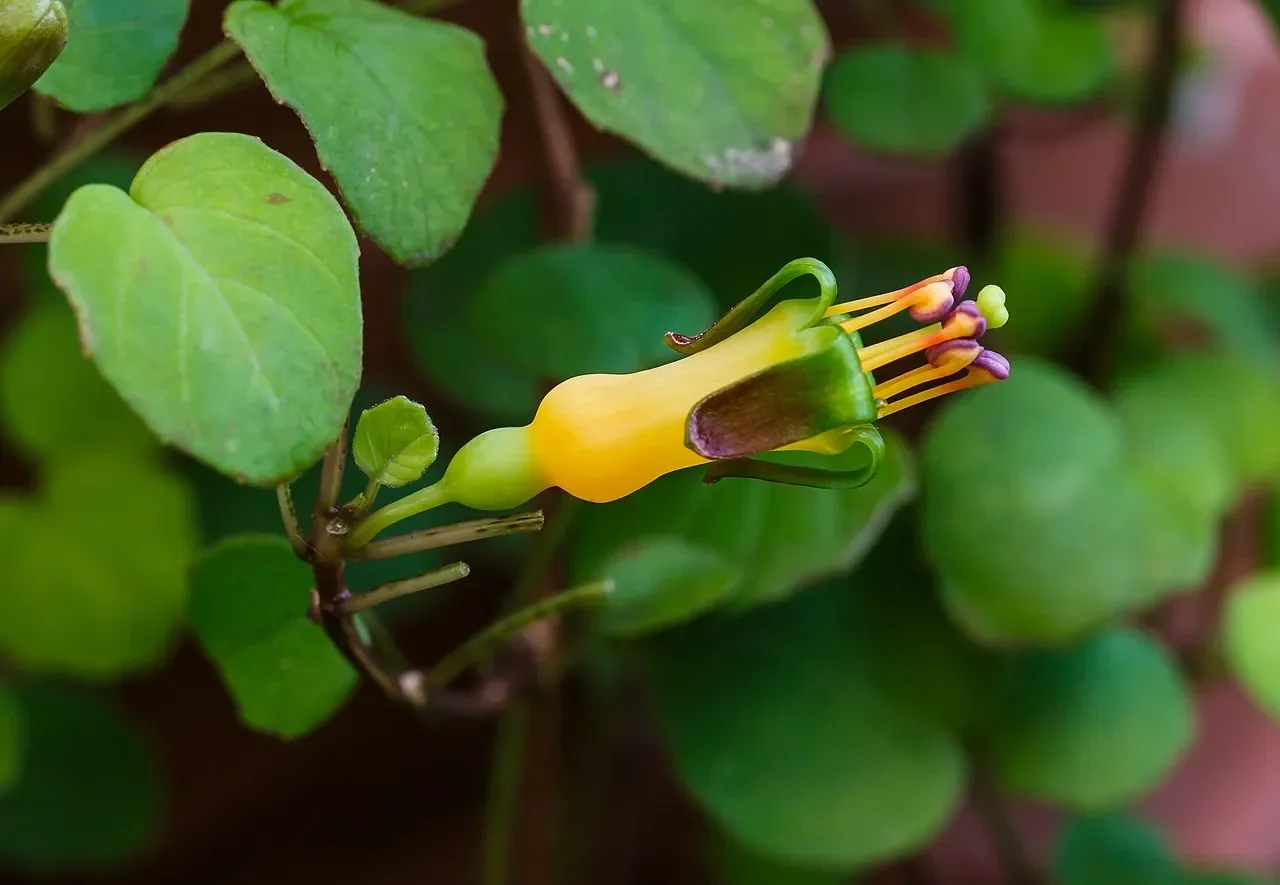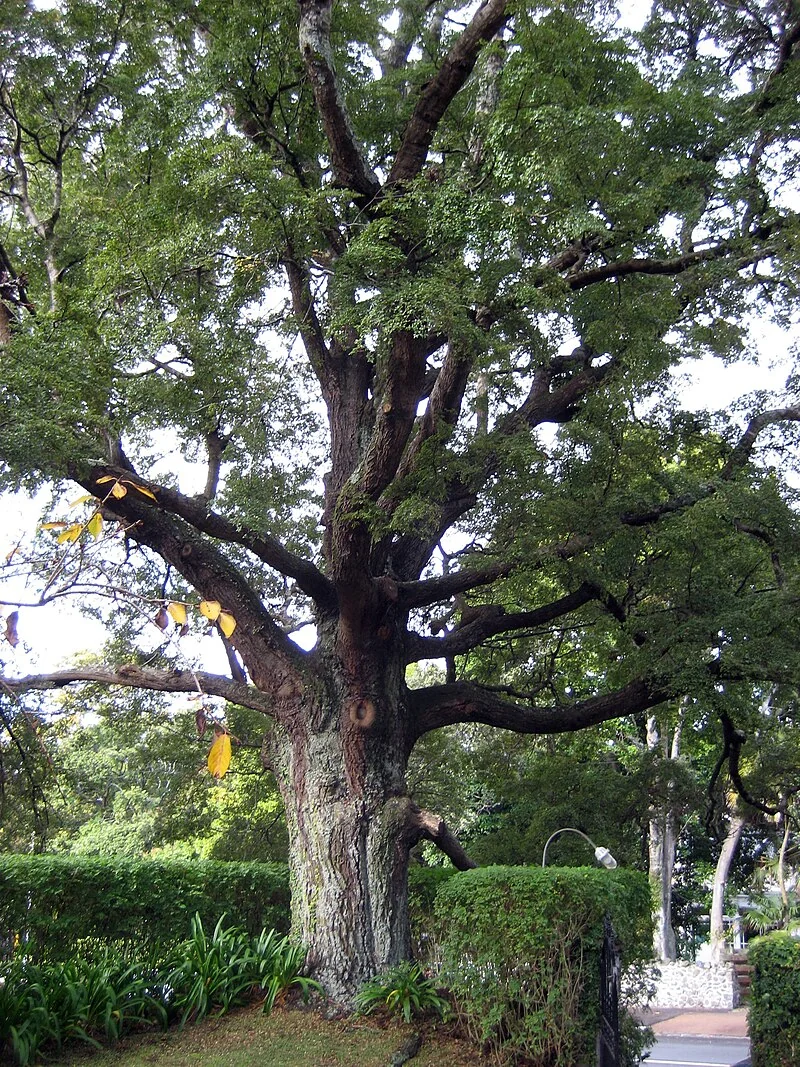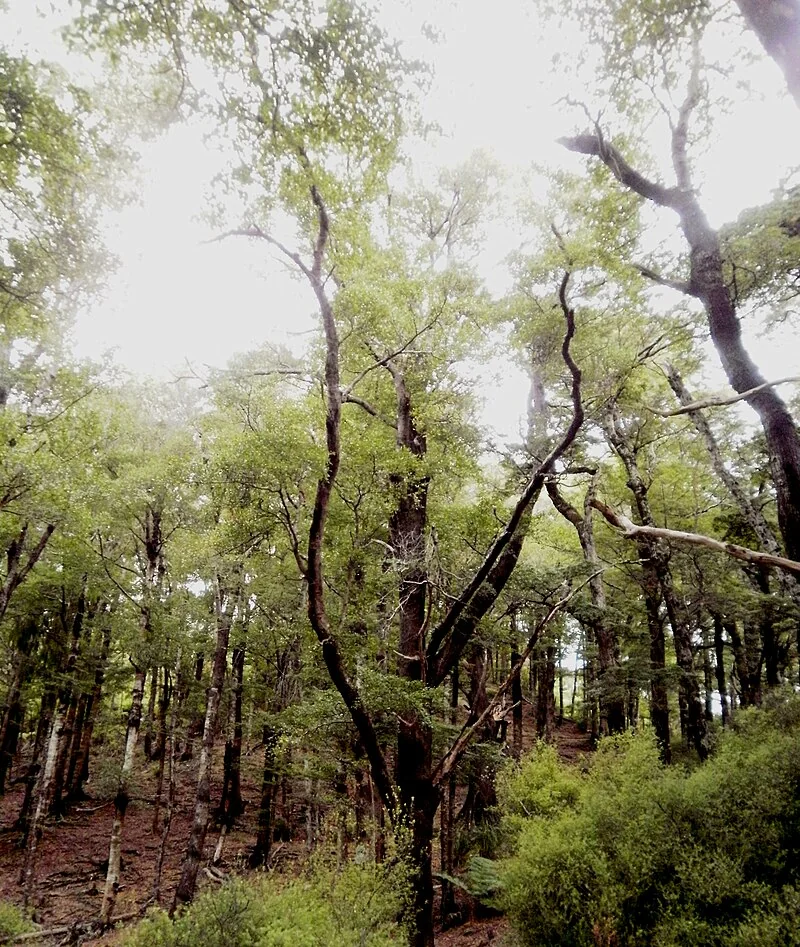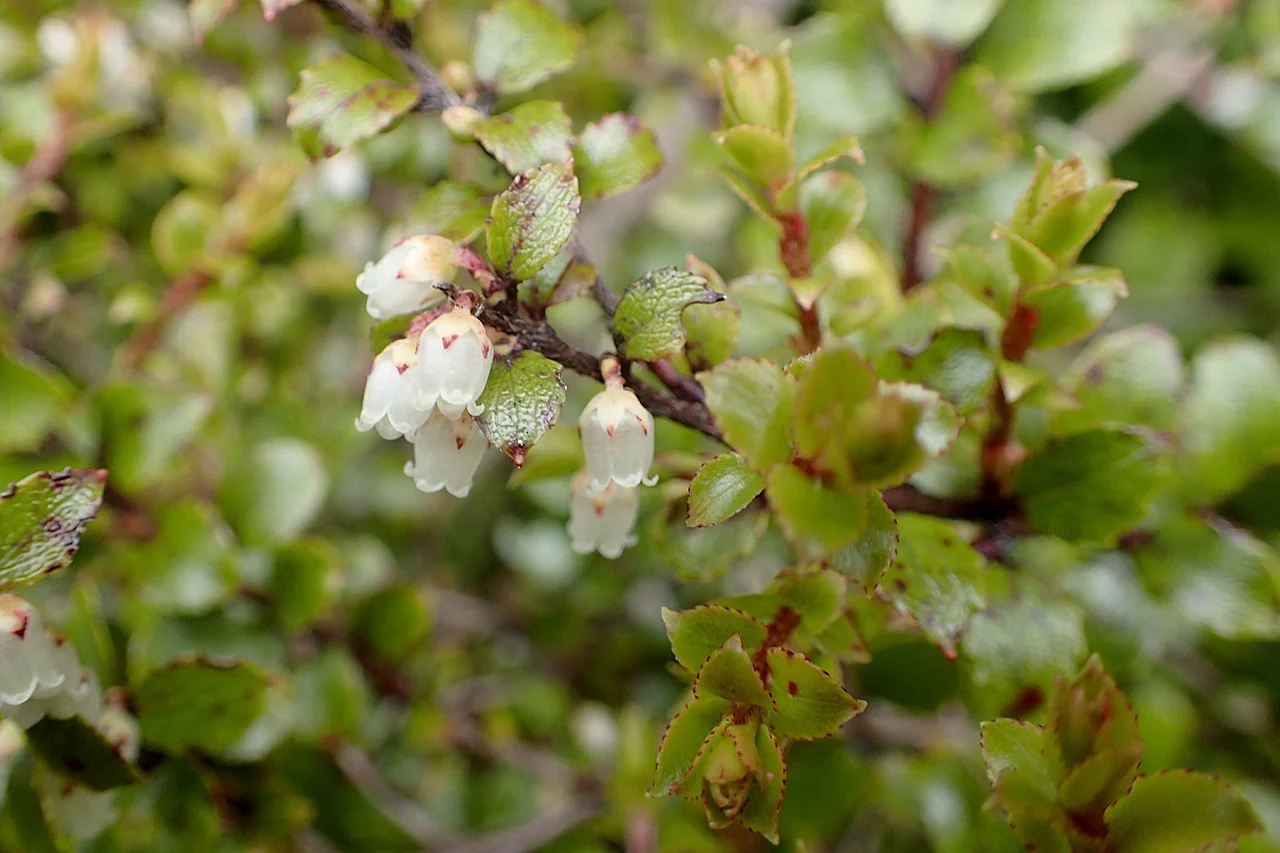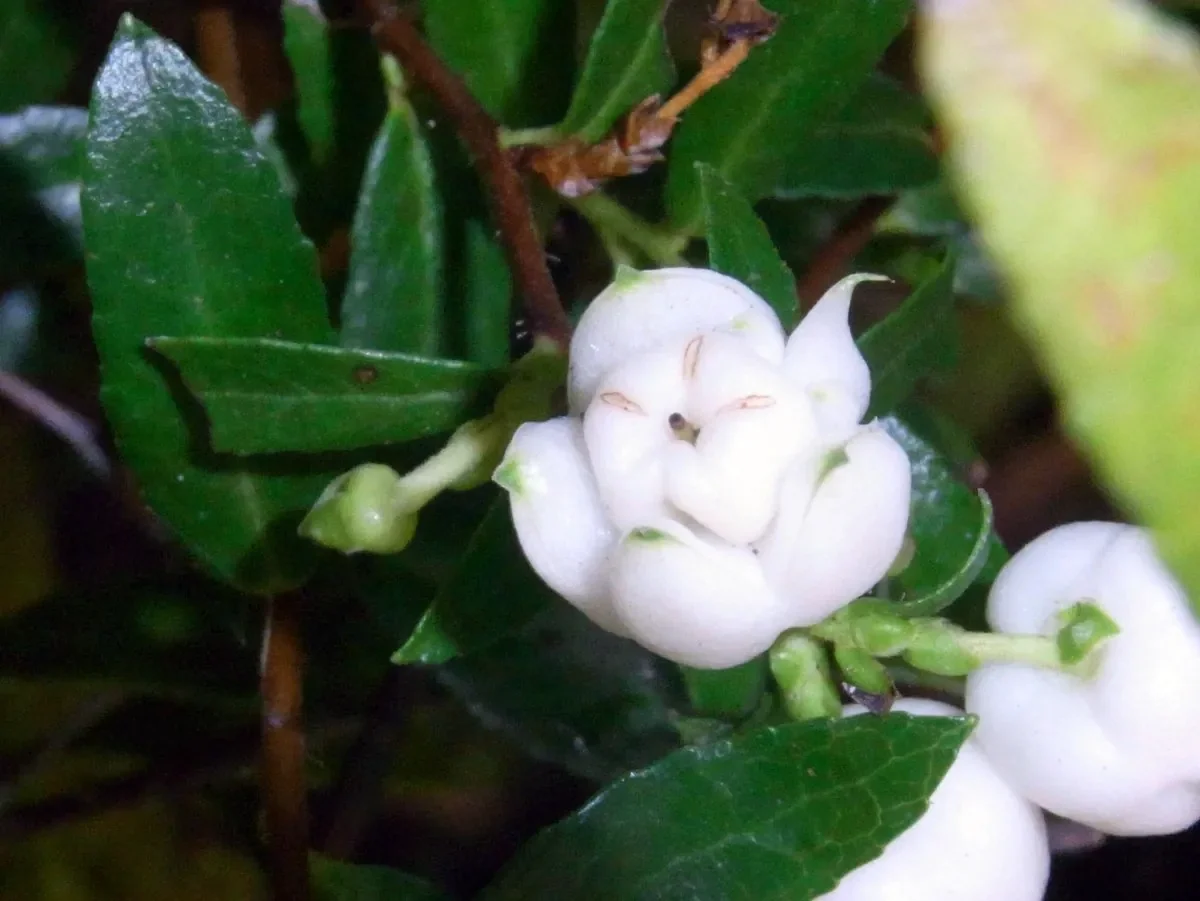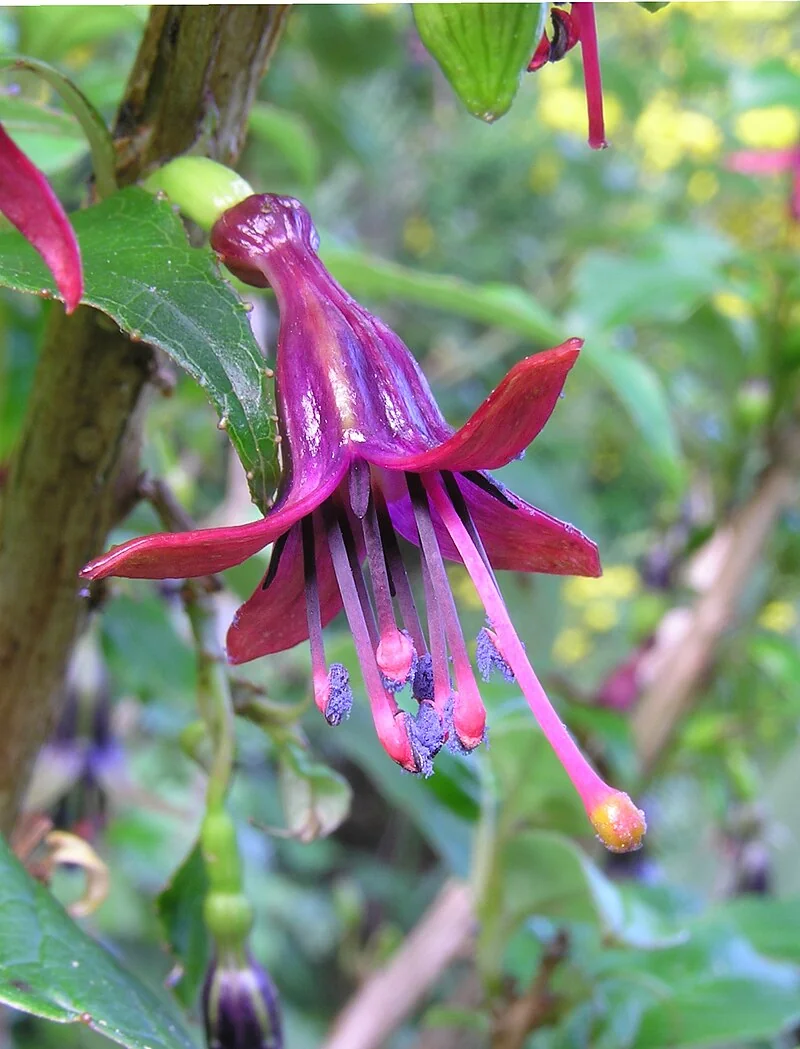
Tree Fuchsia
Fuchsia excorticata
Tree Fuchsia (Fuchsia excorticata) stands as New Zealand's largest native fuchsia and one of the world's few tree-forming members of this predominantly shrubby genus. Known to Māori as K� tare, this remarkable endemic species can reach heights of 15 metres, making it a distinctive component of New Zealand's forest ecosystems. Found throughout both main islands from coastal to montane forests, Tree Fuchsia is easily recognized by its distinctive papery bark that peels in long strips, revealing smooth underlayers beneath. The species plays a crucial ecological role as the sole host for several endemic moths and provides nectar for native birds, making it an essential element in native tree restoration projects.

Plant Description
Botanical Features
Fuchsia excorticata, commonly known as Tree Fuchsia or K� tukutuku, is the largest species of Fuchsia in the world and is endemic to New Zealand. This broadleaf semi-evergreen perennial can grow as a shrub or a tree, typically reaching heights of 8-12 meters, but can grow up to 15 meters in ideal conditions. A distinguishing feature is its bark, which is light brown/orange, extremely thin, and peels in papery strips. The leaves are generally dark green on the upper side and paler, often silvery, on the underside, with serrated margins. They can sometimes be tinged with red or purple. Unlike most New Zealand native trees, it is deciduous in cooler southern regions, though it may be evergreen in warmer areas. Its flowers are solitary and pendulous, emerging in spring and summer, starting green, then transitioning to violet, pink, or dark purple. These nectar-rich flowers attract birds like tui, bellbirds, and hummingbirds. Following the flowers, the tree produces small, dark purple berries known as k� nini by Māori, which are edible and have a sweet, juicy taste.
Quick Facts
| Scientific Name | Fuchsia excorticata |
|---|---|
| Height | 8-15 m |
| Spread | 4-8 m |
| Water Needs | Moderate, prefers consistent moisture |
| Light | Partial shade to dappled light |
| Frost Tolerance | Hardy once established |
| Salt Tolerance | Low |
| Growth Rate | Medium |
| Lifespan | Long |
Climate Best Suited to
Tree Fuchsia (Fuchsia excorticata) occurs naturally throughout New Zealand from sea level to 1000 metres elevation, demonstrating remarkable adaptability to diverse climate conditions. The species thrives in the temperate maritime climate characteristic of most New Zealand regions, preferring areas with consistent moisture and protection from extreme winds. It naturally occurs in forest understoreys and margins where it receives dappled light and shelter, making it well-suited to humid, sheltered positions in cultivation. The species shows good frost tolerance once established, though young plants benefit from protection during their first few winters.
Regional Suitability
| City | Climate Suitability |
|---|---|
| Whangārei | Ideal |
| Auckland | Ideal |
| Hamilton | Ideal |
| Tauranga | Ideal |
| Rotorua | Ideal |
| Gisborne | Ideal |
| New Plymouth | Ideal |
| Napier | Good |
| Whanganui | Ideal |
| Palmerston North | Ideal |
| Wellington | Ideal |
| Nelson | Ideal |
| Christchurch | Good |
| Dunedin | Good |
| Invercargill | Moderate |
Plant Habitat
Fuchsia excorticata, also known as tree fuchsia or k� tukutuku, is endemic to New Zealand. It is found throughout the North and South Islands, as well as Stewart Island and the Auckland Islands.
This species commonly grows in lowland and lower mountainous forest areas, particularly on forest margins, in clearings, and alongside streams and rivers. It can be found from sea level up to approximately 1000 meters (3,300 ft) in elevation. Fuchsia excorticata prefers moist, well-drained, fertile soil and thrives with a canopy overhead for shade, though it can adapt to full sun. It is also abundant in cold mountain areas in the South Island.
Plant Conservation
Fuchsia excorticata, also known as tree fuchsia or k� tukutuku, is classified as "Not Threatened" under the New Zealand Threat Classification System (NZ TCS). This status has been consistent in assessments from 2004, 2009, 2012, 2017, and 2023.
While generally not threatened, the species faces regional declines in some areas, such as Auckland. A significant threat to Fuchsia excorticata is the common brushtail possum, an introduced species in New Zealand, which heavily browses the tree, often leading to defoliation and death. Other threats include plant competitors and, to a lesser extent, goats.
Growing Requirements
Soil Requirements
Tree Fuchsia (Fuchsia excorticata) thrives in well-drained but consistently moist soils with high organic content. In its natural forest habitat, it grows in rich, humus-laden soils formed from decomposing leaf litter. The species prefers slightly acidic to neutral soil conditions and benefits from the addition of organic matter such as compost or well-rotted leaf mould. Good drainage is essential to prevent root rot, particularly during winter months when growth slows.
- Prefers rich, organic soils with good structure
- Requires excellent drainage while maintaining moisture
- Slightly acidic to neutral pH (6.0-7.0) is optimal
- Benefits from regular organic matter incorporation
- Mulching helps maintain soil moisture and temperature
Light Requirements
As a forest understory species, Tree Fuchsia (Fuchsia excorticata) performs best in dappled shade or partial sun conditions. While it can tolerate full sun in cooler, more humid climates, it generally prefers protection from intense afternoon sunlight. The filtered light conditions found beneath larger trees or on the edge of woodlands provide ideal growing conditions, promoting healthy foliage development and abundant flowering.
- Prefers dappled shade to partial sun conditions
- Can tolerate full sun in cool, humid climates
- Benefits from protection during hot afternoons
- Ideal for woodland gardens and forest margins
- Morning sun with afternoon shade works well
Water Requirements
Tree Fuchsia (Fuchsia excorticata) requires consistent soil moisture throughout the growing season but cannot tolerate waterlogged conditions. The species naturally occurs in areas with reliable rainfall and benefits from supplemental watering during dry periods. Once established, it shows reasonable drought tolerance but performs best with regular moisture availability, particularly during flowering and fruit development periods.
- Requires consistent moisture during growing season
- Cannot tolerate waterlogged or poorly drained soils
- Benefits from deep, infrequent watering
- Mulching helps maintain consistent soil moisture
- Reduce watering during winter dormancy period
Planting Guide
Fuchsia excorticata, also known as the New Zealand tree fuchsia or kotukutuku, is the world's largest fuchsia species, capable of reaching heights of up to 15 meters.
1. Planting Location and Time:
- Light: Plant in dappled sunlight or partial shade. While it can adapt to full sun, protection from harsh afternoon sun is beneficial.
- Soil: Choose a location with well-drained, fertile soil that is rich in organic matter.
- Timing: The best time to plant is in early spring, after the last frost.
2. Soil Preparation:
- Ensure the soil is well-draining to prevent waterlogging. A mixture of potting soil with added peat moss or compost can provide necessary nutrients and drainage.
- If planting outdoors, plant the base of the stem 5cm below the soil surface.
3. Watering:
- Maintain consistent moisture, ensuring the soil is evenly moist but not waterlogged.
- Water regularly, potentially every week, especially during the growing season.
4. Temperature and Humidity:
- Fuchsia excorticata prefers cool to moderate temperatures and high humidity.
- It does not tolerate extreme heat or frost well.
- Young trees may require frost protection, and all plants benefit from shelter from cold, drying winds.
5. Fertilizing:
- Apply a native plant fertilizer in spring.
- During active growth (spring through late summer), use a balanced liquid fertilizer (e.g., 10-10-10) every two weeks. Reduce feeding in fall and winter.
6. Pruning:
- Regular pruning is important to encourage flowering and maintain the tree's shape.
- Undertake pruning in early spring as the plant begins active growth.
- Remove dead or weak stems in early spring to enhance airflow and light penetration.
7. Other Considerations:
- Fuchsia excorticata is deciduous in cooler regions but may be evergreen in warmer areas.
- The plant produces attractive green-yellow to purple-red flowers in spring, followed by edible dark purple berries.
- It is resistant to Fuchsia mites.
Ecological Role
Fuchsia excorticata, also known as tree fuchsia or k� tukutuku, plays several important ecological roles in New Zealand's ecosystems:
- Food Source: Its flowers provide nectar for native birds like tūī, bellbirds, and silvereyes, as well as insects. The small, dark purple berries, called k� nini by Māori, are sweet and juicy and are a food source for birds, which in turn aid in seed dispersal.
- Pollination: The flowers, which change color from greenish-yellow to purple-red, are rich in nectar and attract honey-eating birds, making them key pollinators. The species exhibits gynodioecy, with both hermaphrodite and female flowers, which is believed to improve the chances of colonization of isolated islands.
- Habitat and Shelter: As the largest member of the Fuchsia genus, growing up to 12 meters tall, it contributes to the forest structure, particularly in lowland and lower mountainous forest areas, on forest margins, in clearings, and by streams.
- Resilience: Fuchsia excorticata is noted for its resilience, often remaining standing even when nearby forests are destroyed.
- Deciduous Nature: It is one of the few truly deciduous native trees in New Zealand, losing its leaves in autumn, which is unusual among New Zealand trees. It also sheds its bark in red papery strips.
However, the species faces threats, particularly from the introduced common brushtail possum, which considers F. excorticata a preferred food source and can browse individual trees to the point of defoliation and death.
Uses and Significance
Tree Fuchsia (Fuchsia excorticata) plays a crucial role in New Zealand's forest ecosystems as both a nectar source and host plant. The distinctive blue pollen and pendulous red-purple flowers provide nectar for native birds including tāā, bellbirds, and silvereyes, while the species serves as the exclusive host for several endemic moth species. Its berries provide food for forest birds, and the large leaves offer shelter for various invertebrates, making it a keystone species in forest restoration projects.
Garden Uses
- Excellent specimen tree for larger garden spaces
- Distinctive papery bark provides year-round interest
- Attracts native birds with summer nectar display
- Perfect for woodland gardens and native collections
- Valuable for forest restoration and revegetation projects
Landscaping Uses
Fuchsia excorticata, commonly known as Tree Fuchsia or K� tukutuku, is the world's largest fuchsia species and a unique New Zealand native tree with several landscaping applications.
Its Landscaping Uses Include:
- Native Gardens and Ecological Restoration: It is ideal for native gardens, shelter plantings, and ecological restoration projects, contributing to biodiversity.
- Ornamental Value: The tree is admired for its colorful, tubular flowers, which provide a seasonal highlight, and its distinctive peeling, papery orange-brown bark that hangs in red strips. Its twisted branches and lush foliage also make it a striking feature. The flowers are often an unusual combination of deep purple and lime green, changing to bright purple as they mature, and produce striking bright blue pollen.
- Wildlife Attraction: Fuchsia excorticata provides nectar-rich blooms that attract native birds such as tūī and bellbirds, as well as other pollinators and bees. After flowering, it produces edible, dark purple fruits (k� nini) that are sweet and also sought after by birds.
- Versatile Growth Habit: It can grow as a small to medium-sized tree, reaching 5-15 meters tall with a spread of 3-6 meters, and can be pruned to any convenient size, even grown as a bonsai. It is deciduous in cooler regions of New Zealand.
- Adaptability: It establishes well in most New Zealand regions and can grow in riparian soil, making it suitable as a pioneer species in areas with less ideal soil conditions. It prefers moist, fertile soil and partial sun, with protection from strong afternoon sun.
Seasonal Care Calendar
Spring
Spring marks the beginning of active growth for Tree Fuchsia (Fuchsia excorticata), with new leaves emerging and flower buds beginning to develop. This is an excellent time for planting new specimens or conducting any necessary pruning before the growing season begins. Apply organic fertilizer or compost around established plants to support the coming season's growth and flowering.
- New growth begins with fresh leaf development
- Apply organic fertilizer or compost around plants
- Ideal time for planting new specimens
- Conduct formative pruning before active growth
- Monitor soil moisture as temperatures increase
Summer
Summer is the peak flowering season for Tree Fuchsia (Fuchsia excorticata), with the distinctive pendulous red-purple flowers appearing from December through February. This is when the plant provides maximum value to native birds and pollinators. Maintain consistent soil moisture during this period and enjoy the spectacular flowering display that makes this species so distinctive.
- Peak flowering period with pendulous red-purple blooms
- Maintain consistent watering during dry spells
- Maximum nectar production attracts native birds
- Monitor for signs of heat stress in exposed locations
- Avoid major pruning during active flowering
Autumn
During autumn, Tree Fuchsia (Fuchsia excorticata) develops its dark purple berries, providing an important food source for forest birds. This is an excellent time for seed collection if propagation is desired. Begin reducing watering frequency as growth slows and temperatures cool, preparing the plant for its winter dormancy period.
- Dark purple berries ripen, attracting native birds
- Ideal time for collecting fresh seed for propagation
- Reduce watering frequency as growth slows
- Apply mulch to protect roots from winter cold
- Good time for light structural pruning if needed
Winter
Winter is a relatively dormant period for Tree Fuchsia (Fuchsia excorticata), with minimal growth activity. The distinctive papery bark becomes more prominent as a garden feature during the leafless months. This is the optimal time for major structural pruning if required, while the plant is dormant and won't be stressed by the cuts.
- Dormant period with minimal growth activity
- Papery bark provides winter structural interest
- Optimal time for major structural pruning
- Reduce watering significantly during dormancy
- Protect young plants from harsh frosts
When to Prune and How Much
Tree Fuchsia (Fuchsia excorticata) requires minimal pruning to maintain its natural form, though it responds well to shaping when needed. Focus on removing dead, damaged, or crossing branches and maintaining good air circulation through the canopy. The species can be maintained as a large shrub through regular pruning or allowed to develop its natural tree form.
- Remove dead, damaged, or diseased branches any time of year
- Light formative pruning when young helps establish structure
- Major pruning best done in late winter during dormancy
- Can be maintained as shrub through regular pruning
- Thin overcrowded branches to improve air circulation
- Avoid heavy pruning during active growing season
Always use clean, sharp pruning tools to minimize disease risk and ensure clean cuts. The distinctive papery bark should be protected during pruning operations, as damage to the bark can affect the plant's aesthetic appeal and potentially allow disease entry.
How to Grow Tree Fuchsia
Tree Fuchsia (Fuchsia excorticata) can be successfully propagated through several methods, with seed propagation being the most common approach for producing large numbers of plants. Cutting propagation is also effective and allows for the preservation of specific genetic characteristics. The species is relatively easy to grow once the basic requirements are understood and met consistently.
From Seed
Growing Tree Fuchsia from seed is straightforward and provides excellent genetic diversity for restoration projects. Fresh seed offers the best germination rates and should be collected when berries are fully ripe and dark purple in colour.
- Collect ripe dark purple berries from healthy plants in late autumn (March-April) when fruit is fully mature and soft to touch
- Extract seeds by gently crushing berries and washing away pulp with water. The small, hard seeds will sink while pulp floats away
- Sow seeds immediately in a well-draining seed-raising mix, barely covering with fine compost or vermiculite
- Maintain consistent moisture and place in a warm, bright location protected from direct sunlight
- Germination typically occurs within 2-4 weeks at temperatures around 18-22°C
- Transplant seedlings to individual pots when they reach 5-10cm height with several true leaves
- Grow on in containers for at least one full growing season before planting out in permanent positions
- Provide protection from frost and wind during the first winter after planting
Seedlings typically reach flowering size within 3-5 years under good growing conditions, making this an excellent long-term investment for garden establishment.
From Semi-Hardwood Cuttings
Semi-hardwood cutting propagation allows for faster establishment than seed propagation and maintains the exact characteristics of the parent plant, making it useful for preserving specific forms or selections.
- Take 10-15cm cuttings from current season's growth during late summer to early autumn (February-March) when wood has begun to harden
- Remove lower leaves, retaining only 3-4 pairs at the cutting tip to reduce moisture loss
- Make clean cuts just below a node using sharp, sterilized secateurs
- Dip cut end in rooting hormone powder to improve success rates (optional but recommended for faster rooting)
- Insert cuttings into a free-draining propagation mix of equal parts sand and compost
- Maintain high humidity by covering with plastic or placing in a humidity chamber with temperatures around 18-22°C
- Provide bright, indirect light and mist regularly to prevent wilting
- Root development typically occurs within 6-10 weeks - test by gentle tugging
- Pot up rooted cuttings individually and grow on for one season before planting out
- Gradually acclimatize young plants to outdoor conditions before final transplanting
From Softwood Cuttings
Softwood cuttings taken from new spring growth can also be successful, particularly when bottom heat and high humidity are provided consistently throughout the rooting period.
- Select healthy, soft new growth during early spring (September-October)
- Take 8-12cm cuttings early morning when plant tissues are fully hydrated
- Remove lower leaves and treat with rooting hormone if desired
- Insert into moist propagation medium and maintain very high humidity
- Provide gentle bottom heat and protection from direct sunlight
- Expect rooting within 4-6 weeks under optimal conditions
Transplanting and Establishment
Successful establishment of Tree Fuchsia requires careful attention to site selection and post-planting care to ensure plants develop into healthy, long-lived specimens.
- Choose planting sites with dappled shade to partial sun and protection from strong winds
- Prepare soil by incorporating generous amounts of organic matter and ensuring good drainage
- Plant at the same depth as in containers, avoiding burying the stem base
- Water thoroughly after planting and maintain consistent soil moisture throughout the first growing season
- Apply organic mulch around plants to retain moisture and suppress weeds
- Provide stake support for young trees in windy locations
- Monitor for establishment signs including new growth and increased vigour
- Protect from frost and browsing animals during the establishment period
With proper care, Tree Fuchsia establishes relatively quickly and begins producing its distinctive flowers within 2-3 years of planting, developing into a magnificent specimen that will provide decades of garden interest and ecological value.
Pests and Diseases
Fuchsia excorticata, also known as Tree Fuchsia or Kotukutuku, can be susceptible to various pests and diseases. While generally considered hardy, occasional attention may be required to manage these issues.
Common Pests:
- Aphids: These can cause curled or sticky leaves and are often visible on stems, particularly on new, tender growth.
- Capsid bug.
- Fuchsia gall mite: This pest causes distorted leaves and stems.
- Fuchsia flea beetle.
- Glasshouse red spider mite: Symptoms include webbed, dappled, and stripped leaves that may turn red or bronze and drop. Tiny mites can be seen on the undersides of leaves.
- Vine weevil: These can eat the roots of the plant, leading to collapse. Small white grubs are found feeding on roots, and nearby plants like rhodies might show notched leaf margins as a warning sign.
- Slugs: They thrive in moist environments and feed on tender growth. They can be found under pots.
- Thrips: These small, narrow-bodied insects can damage shoots and flower buds, leading to distorted, crinkled leaves and silvery coloration.
- Whiteflies: Small white eggs are laid under leaves, which become sticky. When disturbed, small white flies scatter frantically.
Common Diseases:
- Fuchsia rust: This fungal disease appears as orangish, rusty areas, usually on the undersides of leaves. As it progresses, upper leaf surfaces may turn brown or yellow before dropping. It thrives in cool, moist conditions.
- Grey moulds (Botrytis blight): This fungal disease often presents as fluffy gray mold on plants, particularly in poorly ventilated areas. It can cause spotted, discolored flowers, prevent buds from opening, and lead to wilting leaves and stems.
- Honey fungus: This is a rare susceptibility for Fuchsia excorticata.
- Damping off: This common disease can affect seeds, causing them to fail to germinate or resulting in stunted or wilting seedlings. Water-soaked lesions may form at the base of stems, leading to collapse.
- Verticillium wilt: Foliage turns yellow, pale green, or brown, often starting on one side of the plant. Leaves shrivel and drop, and this fungal disease can be deadly.
- Root and crown rot: This is often caused by poorly drained soil, crowding, or overwatering. Leaves become stunted and discolored before dropping, and roots will appear mushy.
- Viral diseases: Fuchsia plants can be prone to viral diseases like tomato spotted wilt and impatiens necrotic spot virus, which cause curled, spotted leaves and stunted growth. These are often spread by thrips.
- Yellow leaves: This can indicate a lack of magnesium or can be a natural sign of aging.
Cultural Significance
Fuchsia excorticata, known as k� tukutuku by the Māori people, holds significant cultural importance in New Zealand. It is the world's largest fuchsia species and is unique among New Zealand's native trees for being deciduous and shedding its bark in papery strips.
Its Cultural Significance Stems from Various Traditional Uses and Symbolic Meanings:
- Food Source: The dark purple berries, called k� nini, were a vital traditional food source for Māori and were also enjoyed by early European settlers, who used them to make jams and puddings.
- Medicinal Practices (Rongoā Māori): K� tukutuku was used in traditional Māori medicine. Its leaves were an ingredient in vapor baths to assist with childbirth and were also used to treat fevers and bruises.
- Dyes and Cosmetics: The berries were traditionally used to create a purple dye. The distinctive blue pollen from its flowers was used by Māori women as a form of lipstick or makeup.
- Seasonal Indicator: The blooming of k� tukutuku flowers in September served as a traditional indicator in the maramataka (Māori lunar calendar) in the North Island, signaling the time to plant early spring crops like kūmara.
- Symbolism: K� tukutuku symbolizes resilience, beauty in adversity, enduring strength, and grace under pressure, partly because of its ability to thrive in challenging environments. Its peeling bark is seen to represent protection and renewal. It also embodies grace and mana, and is associated with self-discovery and valuing contributions.
- Ceremonial Use: Due to its striking appearance and rich cultural significance, k� tukutuku is often incorporated into formal and traditional events in New Zealand, such as anniversaries and cultural festivals, to celebrate resilience and unity.
- Ecological Role: Beyond its human uses, k� tukutuku plays a crucial role in supporting native wildlife by providing nectar and berries for birds like tūī, bellbirds, and kererū, which are important for seed dispersal.
Bonus Tip
Fuchsia excorticata, the Tree Fuchsia, is full of surprises! It's the world's largest fuchsia species and one of New Zealand's few truly deciduous native trees, shedding its leaves in cooler regions. Its most distinctive feature is its papery, peeling bark, which reveals beautiful reddish-brown underlayers - a natural artwork! And here's a quirky fact: its flowers produce striking bright blue pollen, a rare sight in the plant kingdom, making it a unique and fascinating plant for any garden.
